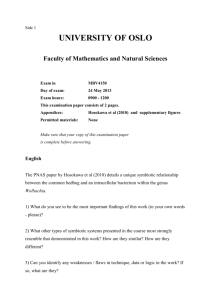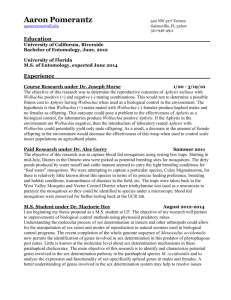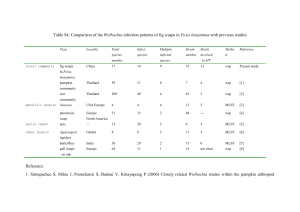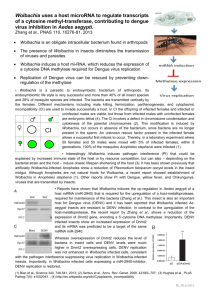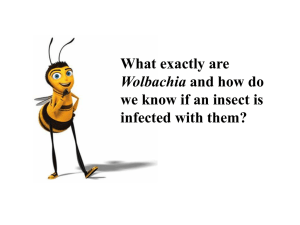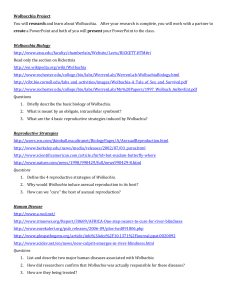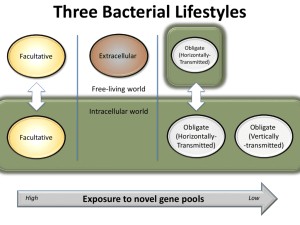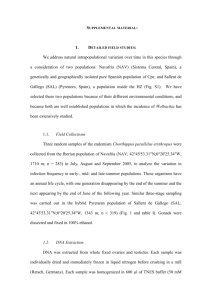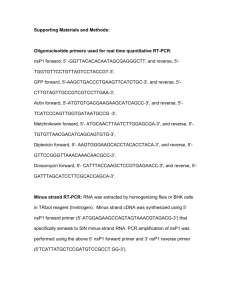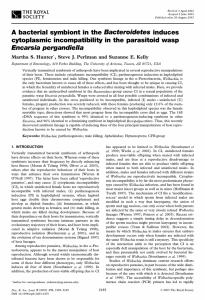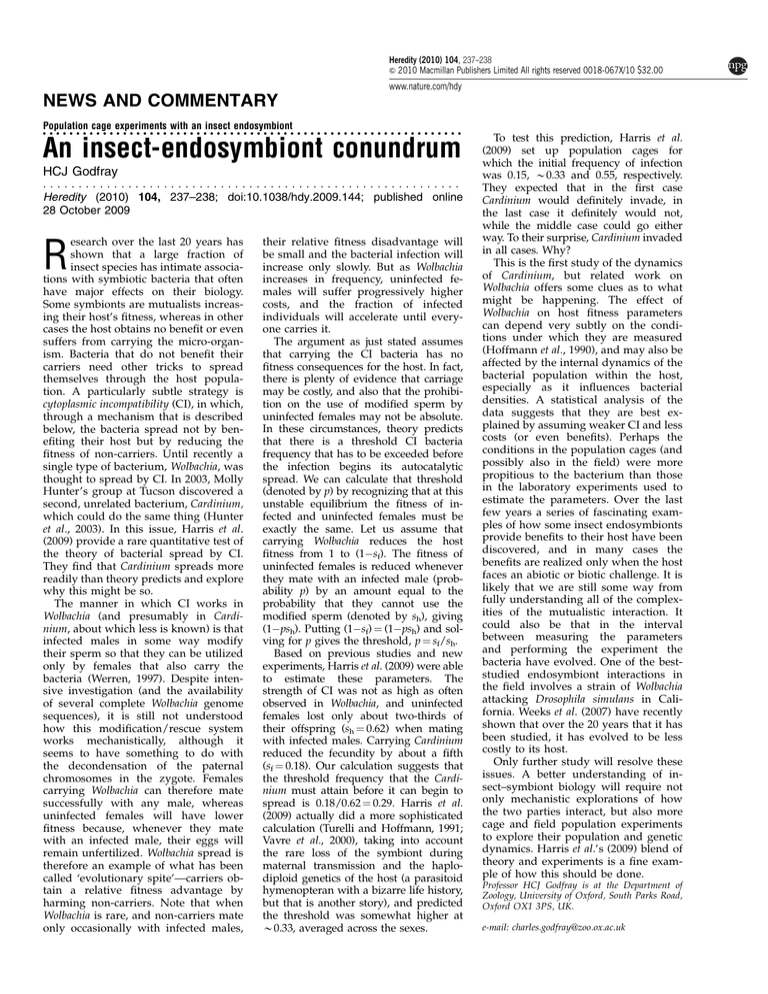
Heredity (2010) 104, 237–238
& 2010 Macmillan Publishers Limited All rights reserved 0018-067X/10 $32.00
www.nature.com/hdy
NEWS AND COMMENTARY
Population cage experiments with an insect endosymbiont
...............................................................
An insect-endosymbiont conundrum
HCJ Godfray
...........................................................
Heredity (2010) 104, 237–238; doi:10.1038/hdy.2009.144; published online
28 October 2009
esearch over the last 20 years has
shown that a large fraction of
insect species has intimate associations with symbiotic bacteria that often
have major effects on their biology.
Some symbionts are mutualists increasing their host’s fitness, whereas in other
cases the host obtains no benefit or even
suffers from carrying the micro-organism. Bacteria that do not benefit their
carriers need other tricks to spread
themselves through the host population. A particularly subtle strategy is
cytoplasmic incompatibility (CI), in which,
through a mechanism that is described
below, the bacteria spread not by benefiting their host but by reducing the
fitness of non-carriers. Until recently a
single type of bacterium, Wolbachia, was
thought to spread by CI. In 2003, Molly
Hunter’s group at Tucson discovered a
second, unrelated bacterium, Cardinium,
which could do the same thing (Hunter
et al., 2003). In this issue, Harris et al.
(2009) provide a rare quantitative test of
the theory of bacterial spread by CI.
They find that Cardinium spreads more
readily than theory predicts and explore
why this might be so.
The manner in which CI works in
Wolbachia (and presumably in Cardinium, about which less is known) is that
infected males in some way modify
their sperm so that they can be utilized
only by females that also carry the
bacteria (Werren, 1997). Despite intensive investigation (and the availability
of several complete Wolbachia genome
sequences), it is still not understood
how this modification/rescue system
works mechanistically, although it
seems to have something to do with
the decondensation of the paternal
chromosomes in the zygote. Females
carrying Wolbachia can therefore mate
successfully with any male, whereas
uninfected females will have lower
fitness because, whenever they mate
with an infected male, their eggs will
remain unfertilized. Wolbachia spread is
therefore an example of what has been
called ‘evolutionary spite’—carriers obtain a relative fitness advantage by
harming non-carriers. Note that when
Wolbachia is rare, and non-carriers mate
only occasionally with infected males,
R
their relative fitness disadvantage will
be small and the bacterial infection will
increase only slowly. But as Wolbachia
increases in frequency, uninfected females will suffer progressively higher
costs, and the fraction of infected
individuals will accelerate until everyone carries it.
The argument as just stated assumes
that carrying the CI bacteria has no
fitness consequences for the host. In fact,
there is plenty of evidence that carriage
may be costly, and also that the prohibition on the use of modified sperm by
uninfected females may not be absolute.
In these circumstances, theory predicts
that there is a threshold CI bacteria
frequency that has to be exceeded before
the infection begins its autocatalytic
spread. We can calculate that threshold
(denoted by p) by recognizing that at this
unstable equilibrium the fitness of infected and uninfected females must be
exactly the same. Let us assume that
carrying Wolbachia reduces the host
fitness from 1 to (1sf). The fitness of
uninfected females is reduced whenever
they mate with an infected male (probability p) by an amount equal to the
probability that they cannot use the
modified sperm (denoted by sh), giving
(1psh). Putting (1sf) ¼ (1psh) and solving for p gives the threshold, p ¼ sf/sh.
Based on previous studies and new
experiments, Harris et al. (2009) were able
to estimate these parameters. The
strength of CI was not as high as often
observed in Wolbachia, and uninfected
females lost only about two-thirds of
their offspring (sh ¼ 0.62) when mating
with infected males. Carrying Cardinium
reduced the fecundity by about a fifth
(sf ¼ 0.18). Our calculation suggests that
the threshold frequency that the Cardinium must attain before it can begin to
spread is 0.18/0.62 ¼ 0.29. Harris et al.
(2009) actually did a more sophisticated
calculation (Turelli and Hoffmann, 1991;
Vavre et al., 2000), taking into account
the rare loss of the symbiont during
maternal transmission and the haplodiploid genetics of the host (a parasitoid
hymenopteran with a bizarre life history,
but that is another story), and predicted
the threshold was somewhat higher at
B0.33, averaged across the sexes.
To test this prediction, Harris et al.
(2009) set up population cages for
which the initial frequency of infection
was 0.15, B0.33 and 0.55, respectively.
They expected that in the first case
Cardinium would definitely invade, in
the last case it definitely would not,
while the middle case could go either
way. To their surprise, Cardinium invaded
in all cases. Why?
This is the first study of the dynamics
of Cardinium, but related work on
Wolbachia offers some clues as to what
might be happening. The effect of
Wolbachia on host fitness parameters
can depend very subtly on the conditions under which they are measured
(Hoffmann et al., 1990), and may also be
affected by the internal dynamics of the
bacterial population within the host,
especially as it influences bacterial
densities. A statistical analysis of the
data suggests that they are best explained by assuming weaker CI and less
costs (or even benefits). Perhaps the
conditions in the population cages (and
possibly also in the field) were more
propitious to the bacterium than those
in the laboratory experiments used to
estimate the parameters. Over the last
few years a series of fascinating examples of how some insect endosymbionts
provide benefits to their host have been
discovered, and in many cases the
benefits are realized only when the host
faces an abiotic or biotic challenge. It is
likely that we are still some way from
fully understanding all of the complexities of the mutualistic interaction. It
could also be that in the interval
between measuring the parameters
and performing the experiment the
bacteria have evolved. One of the beststudied endosymbiont interactions in
the field involves a strain of Wolbachia
attacking Drosophila simulans in California. Weeks et al. (2007) have recently
shown that over the 20 years that it has
been studied, it has evolved to be less
costly to its host.
Only further study will resolve these
issues. A better understanding of insect–symbiont biology will require not
only mechanistic explorations of how
the two parties interact, but also more
cage and field population experiments
to explore their population and genetic
dynamics. Harris et al.’s (2009) blend of
theory and experiments is a fine example of how this should be done.
Professor HCJ Godfray is at the Department of
Zoology, University of Oxford, South Parks Road,
Oxford OX1 3PS, UK.
e-mail: charles.godfray@zoo.ox.ac.uk
News and Commentary
238
Harris LR, Kelly SE, Hunter MS, Perlman SJ
(2009). Population dynamics and rapid
spread of Cardinium, a bacterial endosymbiont causing cytoplasmic incompatibility in Encarsia pergandiella (Hymenoptera:
Aphelinidae). Heredity 104: 239–246.
Hoffmann AA, Turelli M, Harshman LG (1990).
Factors affecting the distribution of cytoplasmic incompatibility in Drosophila simulans.
Genetics 126: 933–948.
Hunter MS, Perlman SJ, Kelly SE (2003). A
bacterial symbiont in the Bacteroidetes induces
cytoplasmic incompatibility in the parasitoid
wasp Encarsia pergandiella. Proc R Soc London
B Biol 270: 2185–2190.
Turelli M, Hoffmann AA (1991). Rapid spread
of an inherited incompatibility factor in
California Drosophila. Nature 353: 440–442.
Heredity
Vavre F, Fleury F, Varaldi J, Fouillet P, Bouletreau M
(2000). Evidence for female mortality in Wolbachia-mediated cytoplasmic incompatibility in
haplodiploid insects: epidemiologic and evolutionary consequences. Evolution 54: 191–200.
Weeks AR, Turelli M, Harcombe WR, Reynolds
KT, Hoffmann AA (2007). From parasite to
mutualist: rapid evolution of Wolbachia in
natural populations of Drosophila. PLoS Biol 5:
997–1005.
Werren JH (1997). Biology of Wolbachia. Annu Rev
Entomol 42: 587–609.
Editor’s suggested reading
Clark ME, Bailey-Jourdain C, Ferree PM,
England SJ, Sullivan W, Windsor DM et al.
(2008). Wolbachia modification of sperm
does
not
always
require
residence
within developing sperm. Heredity 101:
420–428.
White JA, Kelly SE, Perlman SJ, Hunter MS (2009).
Cytoplasmic incompatibility in the parasitic
wasp Encarsia inaron: disentangling the roles
of Cardinium and Wolbachia symbionts.
Heredity 102: 483–489.
Ros VID, Breeuwer JAJ (2009). The effects of, and
interactions between, Cardinium and Wolbachia in the doubly infected spider mite Bryobia
sarothamni. Heredity 102: 413–422.
Echaubard P, Duron O, Agnew P, Sidobre C, Noël
V, Weil M et al. (2009). Rapid evolution of
Wolbachia density in insecticide resistant
Culex pipiens. Heredity (e-pub ahead of print
5 August 2009).

